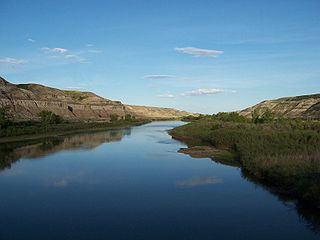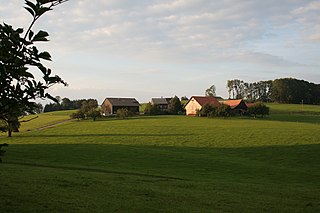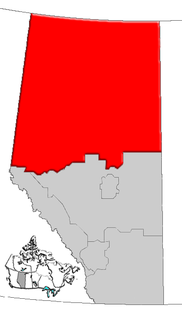
Cushing is a city in Payne County, Oklahoma, United States. The population was 7,826 at the 2010 census, a decline of 6.5% from 8,371 at the 2000 census.

The Athabasca River originates from the Columbia Glacier of the Columbia Icefield in Jasper National Park in Alberta, Canada. The impressive and scenic Athabasca Falls is located upstream about 30 km (19 mi) from the Jasper townsite.

Wood Buffalo National Park is the largest National Park of Canada at 44,807 km2 (17,300 sq mi). It is located in northeastern Alberta and the southern Northwest Territories. Larger in area than Switzerland, it is the second-largest national park in the world. The park was established in 1922 to protect the world's largest herd of free roaming wood bison, currently estimated at more than 5,000. It is one of two known nesting sites of whooping cranes.
Enbridge Inc. is a Canadian multinational energy transportation company based in Calgary, Alberta. It focuses on the transportation, distribution and generation of energy, primarily in North America. As a transporter of energy, Enbridge operates in Canada and the United States, the longest crude oil and liquid hydrocarbons transportation system in North America. As a distributor of various fuels, it owns and operates Canada's largest natural gas distribution network, providing distribution services in Ontario, Quebec, New Brunswick and New York State.
First Nations in Alberta are Indigenous peoples who live in the Canadian province of Alberta. The First Nations are peoples recognized as Aboriginal peoples in Canada excluding the Inuit and the Métis. According to the 2011 Census, a population of 116,670 Albertans self-identified as First Nations. Specifically there were 96,730 First Nations people with registered Indian Status and 19,945 First Nations people without registered Indian Status. Alberta has the third largest First Nations population among the provinces and territories. From this total population, 47.3% of the population lives on an Indian reserve and the other 52.7% live in urban centres. According to the 2011 Census, the First Nations population in Edmonton totalled at 31,780, which is the second highest for any city in Canada. The First Nations population in Calgary, in reference to the 2011 Census, totalled at 17,040. There are 48 First Nations or "bands" in Alberta, belonging to nine different ethnic groups or "tribes" based on their ancestral languages.

Lesser Slave Lake is a provincial electoral district for the Legislative Assembly of Alberta, Canada. It has existed since 1971 and is mandated to return a single member using the first past the post method of voting.

The Red Deer River is a river in Alberta and a small portion of Saskatchewan, Canada. It is a major tributary of the South Saskatchewan River and is part of the larger Saskatchewan-Nelson system that empties into Hudson Bay.

Division No. 17 is a census division in Alberta, Canada. It spans the central and northwest portions of northern Alberta and its largest urban community is the Town of Slave Lake. Division No. 17 is the largest census division in Alberta according to area and also has the lowest population density.

Petroleum production in Canada is a major industry which is important to the economy of North America. Canada has the third largest oil reserves in the world and is the world's seventh largest oil producer and fifth largest oil exporter. In 2015 it produced an average of 621,610 cubic metres per day (3.9 Mbbl/d) of crude oil and equivalent. Of that amount, 61% was upgraded and non-upgraded bitumen from oil sands, and the remainder light crude oil, heavy crude oil and natural-gas condensate. Most of Canadian petroleum production is exported, approximately 482,525 cubic metres per day (3 Mbbl/d) in 2015, with almost all of the exports going to the United States. Canada is by far the largest single source of oil imports to the United States, providing 43% of US crude oil imports in 2015.

Cadotte Lake is an unincorporated community in northern Alberta, Canada within Northern Sunrise County. It is located on the northern shore of the homonymous lake, along Highway 986, 79 km (49 mi) east of Peace River and 68 km (42 mi) west of the Bicentennial Highway.
Gleniffer Lake also known as Gleniffer Reservoir is an artificial lake in central Alberta, Canada created in 1983 by the construction of the Dickson Dam which impounded the Red Deer River, a major tributary of the South Saskatchewan River which flows into the Saskatchewan River Basin.
The Enbridge Northern Gateway Pipelines was a project to build a twin pipeline from Bruderheim, Alberta to Kitimat, British Columbia. The eastbound pipeline would have imported natural gas condensate and the westbound pipeline would have exported diluted bitumen from the Athabasca oil sands to a marine terminal in Kitimat for transportation to Asian markets via oil tankers. The project would have also included terminal facilities with "integrated marine infrastructure at tidewater to accommodate loading and unloading of oil and condensate tankers, and marine transportation of oil and condensate." The $CDN 7.9 billion project was proposed in mid-2000s and has been postponed several times. The proposed project would have been developed by Enbridge Inc., a Canadian crude oil and liquids pipeline and storage company.

The Long Lake oil sands upgrader project is an in situ oil extraction project 40 km (25 mi) southeast of Fort McMurray in the Athabasca oil sands region of Alberta. The upgrader side of the facility has been shut down indefinitely after the deaths of two workers caused by an explosion January 16, 2016 in the Hydrocracker Unit however the SAGD site is still operational. The project is operated by Nexen, a wholly owned subsidiary of China National Offshore Oil Corporation (CNOOC) Limited. Long Lake is an integrated steam-assisted gravity drainage (SAGD) and upgrading operation that uses a proprietary OrCrude technology as well as hydrocracking and gasification to produce Premium Synthetic Crude (PSC) oil. Production capacity at Long Lake is 72,000 barrels per day (11,400 m3/d) of bitumen which, when upgraded, generates approximately 58,500 barrels per day (9,300 m3/d) of crude oil.
The Beaver Lake Cree Nation is a First Nations band government located 105 kilometres (65 mi) northeast of Edmonton, Alberta, representing people of the Cree ethno-linguistic group in the area around Lac La Biche, Alberta, where the band office is currently located. Their treaty area is Treaty 6. The Intergovernmental Affairs office consults with persons on the Government treaty contacts list. There are two parcels of land reserved for the band by the Canadian Crown, Beaver Lake Indian Reserve No. 131 and Blue Quills First Nation Indian Reserve. The latter reserve is shared by six bands; Beaver Lake Cree Nations, Cold Lake First Nations, Frog Lake First Nation, Heart Lake First Nation, Kehewin Cree Nation, Saddle Lake Cree Nation.
The North Peace Tribal Council represents five First Nations in northwestern Alberta, Canada. The North Peace Tribal Council was incorporated in 1987, by the Beaver First Nation, Dene Tha' First Nation, Little Red River Cree First Nation, and Tallcree Tribal Government. The Lubicon Lake Nation was accepted into membership in 1995, but left in 2013.

The Tar Sands Healing Walk began in 2010. It was founded by Jesse Cardinal, in collaboration with the indigenous women of Keepers of the Athabasca. Eriel Tchekwie Deranger, a Dene women, is the main organizer. One of Eriel’s co-organizers for the Healing Walk is Melina Laboucan-Massimo, a Lubicon Cree environmental activist. Over four consecutive years the Tar Sands Healing Walk brings together hundreds of people to walk in a spiritual gathering to protect culture, environment and climate from the expansion of the tar sands. This women's initiative aims to unite the peoples of the Athabasca River and Lake Watershed to secure and protect water and watershed lands for ecological, social, cultural and community health and well being.
Melina Laboucan-Massimo is a Greenpeace Activist who advocates for indigenous rights and ecological well-being in Canada. Massimo is most known for her installation of a solar panel system in Little Buffalo called The Solar Project.


















